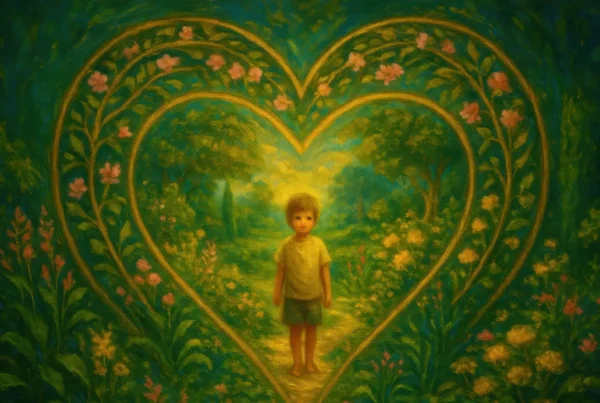BOOK YOUR WORKSHOP TODAY
All posts published here are presented as casual conversation pieces to provoke thought in some direction or another, they do not necessarily represent fixed opinions of the Inner Council, as our work exists beyond the spectrum of bound statement and singular clause.
A practical and mythic exploration of how Inner Child work restores the lost Inner King—reviving sovereignty, clarity, purpose, and emotional wholeness.
Key Takeaways
- The Inner King collapses when childhood safety and emotional mirroring fail.
- The Inner Child holds the original blueprint for sovereignty and purpose.
- Men cannot sustain clarity or presence while their inner child remains in ashes.
- Re-parenting the Inner Child rebuilds internal authority and emotional safety.
- True kingship emerges naturally when the child no longer feels abandoned.
- The revival of the Inner King is a reunion, not an achievement—grounded in integration.
The Collapse of the Inner King and the Wound Behind It
Across modern culture, men report the same inner dilemma: “Something in me that should be guiding my life is missing.” Robert Bly names it the absence of the King—the collapse of the inner source of direction, blessing, and integrity. In traditional cultures, father-presence, initiation, craft apprenticeship, and ritual provided a stable architecture for this King-energy to take shape within the psyche. Today, those structures are fractured, and the internal King often never develops or dies early.
Inner Child work helps us locate where this collapse begins. Before a boy ever senses a mythic King, he first learns the shape of authority through early relational safety. He discovers his own agency, his budding preferences, his emotional reality. If his environment is unstable—absent fathering, emotional volatility, shame, or unpredictability—the child’s internal sense of rightness contracts. The King, as Bly says, “falls over and dies,” not metaphorically but psychologically. The child loses felt permission to exist as himself.
When the father becomes distant, opaque, or feared, the boy’s inner compass turns toward survival: pleasing, shrinking, hiding, performing, or withdrawing. These early adaptations silently replace sovereignty. What grows is a self built around external moods and expectations. The King cannot stand upright on a foundation shaped by fear or emotional depletion.
Inner Child work, therefore, is not merely therapeutic—it is constitutional. It restores the inner conditions that make the rise of the King possible. It addresses the root: the early fragmentation that precedes adult confusion. Before a man can reclaim authority, the child within him must reclaim safety.
The Inner Child: The Forgotten Heir to the Throne
If the King represents maturity, direction, and meaning, the Inner Child represents the living core from which kingship is built. Bly’s imagery of “ashes,” “soot,” and “the boy hiding his golden hair” mirrors what Inner Child practitioners see every day: brilliant, sensitive young selves forced to bury their gifts to survive the emotional climate of their home.
The Inner Child holds the early blueprint for sovereignty—joy, curiosity, intuition, spontaneity, and unfiltered preference. When a child grows up catering to parental moods, navigating volatility, or protecting themselves from criticism or absence, they lose touch with these inner signals. Over time, the internal King cannot emerge because the heir—this child-self—has been exiled.
Men often come into Inner Child work believing their problem is lack of discipline, purpose, or will. In truth, their difficulty is developmental: a younger part of them is still frozen in the emotional conditions that originally silenced their sovereignty. This child cannot lead a kingdom; he is still waiting to be rescued.
The Inner Child is the first sovereign. He is the original holder of desire, imagination, and agency. Without his restoration, adult sovereignty becomes imitation: performing success, chasing spiritual highs, over-identifying with ideals, or flying too close to the sun—what Bly calls the “ascensionist son.” Men may experience moments of power or clarity, but they cannot remain there. The internal “kingdom” is still governed by a frightened child.
To revive the King, we must first return to the ashes and bring the child out—not as a symbolic act, but as an emotional reality.
How the Inner King Rises Through the Healing of the Child
The King archetype emerges not through achievement or status but through integration. He rises when the inner child no longer feels alone, ashamed, or endangered. Inner Child work provides a structured pathway for this integration.
A man begins by meeting the young self he abandoned—sometimes consciously, more often unconsciously. This encounter is not sentimental. It is a reckoning. He sees the child who learned to be small, deferential, angry, invisible, overly responsible, or relentlessly accommodating. Instead of pushing this part away, he listens.
This listening is the beginning of kingship.
In Inner Child work, the adult self becomes the protector the child never had—the internal father who provides safety, structure, and compassion. When this relationship stabilizes, the child begins to release survival patterns and trust the adult. This creates psychic ground—firm, steady, and free of panic—on which the King can stand.
Bly says that adults do not “stay with the King” because their souls are still contaminated with infantile anger, grief, and unmet longing. Inner Child work processes these unfinished emotions so the adult psyche is no longer hijacked by the child’s unmet needs. As the child heals, emotional clarity emerges. Decisions become cleaner. Purpose becomes intuitive. Boundaries strengthen without aggression. The King’s qualities—blessing, order, direction, generosity—flow naturally.
The King rises not as an ideal but as an internal reality anchored in the healed child. When the boy is safe, the man becomes sovereign.
Narrative: The Boy in the Ashes

There was once a boy who lived in a house where the adults’ moods were as unpredictable as storms. Sometimes there was warmth—brief, flickering—but most days the air was thick with silence or sharp with tension. The boy learned to read the room faster than he learned to read words. He hid his golden hair beneath a cap because light always attracted trouble.
One day he wandered into the lowest room of the psyche—the kitchen of ashes. He curled there, soot on his clothes, listening to the footsteps above. He learned to be small. He learned to apologise before speaking. He learned to disappear.
But he also learned something else: he could hear faint knocking from another room in the castle. A distant presence—a King he had heard of but never seen. He felt drawn to that voice, though he did not know why.
The boy wanted to bring a bowl of soup to the King, as the story goes. But every time he tried to leave the ashes, the child part of him whispered: “We are not allowed upstairs.”
This is where many men remain emotionally: grown bodies, but children stuck in the kitchen. Their kingship does not arise because the child within them still believes he is unworthy of walking through the door.
The revival of the Inner King begins here—not in triumph, but in soot. Not in upward ascension, but in returning to the boy who never left the ashes.
The Descent of the Man and the First Conversation
Years later, the boy’s body became a man’s body, but the boy remained inside—quiet, cautious, waiting. The man lived competently, sometimes brilliantly, but his decisions were brittle. He felt moments of purpose, but they evaporated. He could rise high for a while—the ascensionist son—but inevitably fell back into confusion.
One night, exhausted from holding himself together, the man descended inward. He followed a corridor he had ignored for years. At the end, he found the kitchen—the soot-covered boy sitting exactly where he’d left him.
The boy looked up first.
“Are you here to make me leave again?” he asked.
The man knelt. “No,” he said. “I’m here because I finally realised you’re the one who was afraid all this time.”
The boy blinked. “I only knew how to keep us safe.”
“I know,” the man said, and his voice cracked.
This moment—the first moment of genuine internal compassion—is the hinge of transformation. Bly says the King rises when the soul becomes ready for blessing. In Inner Child work, this readiness appears when the adult self stops demanding perfection from the child and instead offers understanding.
The boy hesitated. “Will you stay this time?”
The man nodded. “As long as you need.”
Something shifted. A warmth entered the room. The boy’s golden hair glimmered faintly beneath the soot.
When a man returns to the boy rather than abandoning him, the King inside him stirs.
The Return of the Inner King
Over time, the man visited the boy daily. He listened to old fears, cleaned the soot from forgotten memories, and taught the child that emotions were not danger signals but messages. The boy began to trust him. Sometimes he even laughed—a sound the man realised he had been missing for decades.
One morning, the boy said, “I think we can go upstairs now.”
Together they climbed the staircase. The castle, once dim and echoing, seemed brighter. At the top of the stairs was a door the man had never dared open. When he pushed it, the room flooded with light.
There sat the King—not a towering figure, but a calm presence. Not a mythic ruler, but an inner source of clarity. The King did not speak; he did not need to. His presence was order, direction, blessing.
The boy stepped forward first. “This is my friend,” he said. “He came back for me.”
The King nodded. “Then he may enter.”
The man felt something settle in him—a quiet authority he had never known. No grand vision, no thunderbolt. Just a grounded rightness. The kind of sovereignty a man can build a life with.
And this is how the Inner King returns:
Not through conquering.
Not through ascension.
But through reunion—between the man and the child he once was.
When the child is restored, the King rises.
When the King rises, the man becomes whole.
The King, the Boy, and the Wild Man
One of the most overlooked truths in Iron John is that the King cannot return without the Wild Man, and the Wild Man cannot appear without the wounded boy who begins the journey.
Bly makes it clear:
- The Wild Man is the keeper of instinct, depth, feeling, grief, initiation, and soul.
- The King is the keeper of order, blessing, sovereignty, and generativity.
And the boy—the one who falls into the cage and releases the Wild Man—is the bridge between them.
This triangular relationship maps perfectly onto the Inner Council system:
- The Inner Child = the boy, the one who discovers the wound and begins the descent.
- The Inner Wild Self / Somatic Self = the Wild Man, the one who holds what the ego cannot.
- The Inner King = the mature, integrated self that rises only after the descent.
Bly says that when the boy climbs onto the Wild Man’s shoulders, he rises.
When he enters the pond and loses his finger, he descends.
When he endures the ashes, he learns humility.
Only then is he able to meet the second King.
In Inner Child work, these are not mythic events but psychological movements:
- The rising is the brief contact with our potential.
- The descent is the confrontation with our wound.
- The ashes are the period of emotional truth-telling, shame-releasing, and humility.
- The second King is the integrated adult self that emerges only when the child and the Wild Man are both included.
Bly writes that the King is not reached through perfection or spiritual flight but through the willingness to touch the wound, to descend, and to endure the kitchen stage.
This is precisely why Inner Child work revives the King:
It leads the man to the place where the Wild Man waits, and it is the Wild Man who finally reveals the King.
The King rises because the Child is healed—
and the Child heals because the Wild Man is released.
This is the alchemy at the center of both Iron John and Inner Council practice:
sovereignty through descent, wholeness through integration.
And visit our Inner Child Workshop page for more information.





